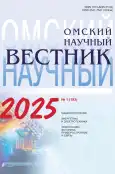The use of mathematical model to evaluate the material balance of a solid oxide electrolyser
- 作者: Golodnova A.I.1, Erpalov M.V.1, Golodnov A.I.2
-
隶属关系:
- Institute of High-Temperature Electrochemistry of the Ural Branch of the Russian Academy of Sciences
- Ural Federal University
- 期: 卷 193, 编号 1 (2025)
- 页面: 68-75
- 栏目: ENERGY AND ELECTRICAL ENGINEERING
- URL: https://bakhtiniada.ru/1813-8225/article/view/284672
- DOI: https://doi.org/10.25206/1813-8225-2025-193-68-75
- EDN: https://elibrary.ru/DNZJSS
- ID: 284672
如何引用文章
全文:
详细
The effective use of solid oxide electrolysers is a promising solution for the energy sector and industry in general. Therefore, scientists all over the world are conducting research on improving the electrolysers' efficiency and reliability. In this paper, a mathematical model of the material balance for a solid oxide electrolyser is considered, which allows optimizing the operating parameters of existing equipment and newly designed equipment.
In particular, special attention is focused on studying the effect of the operating parameters of electrochemical plants of planar design during electrolysis on the composition of reaction products. The relation between the compositions of reagents at the inlet and products at the outlet is determined on the basis of calculated data for a planar solid oxide electrolyser using mathematical modeling in comparison with experimental data.
作者简介
Anastasia Golodnova
Institute of High-Temperature Electrochemistry of the Ural Branch of the Russian Academy of Sciences
编辑信件的主要联系方式.
Email: a.golodnova@ihte.ru
ORCID iD: 0000-0003-2598-2269
SPIN 代码: 3510-7011
Junior Researcher, Laboratory of Electrochemical Devices and Fuel Cells
俄罗斯联邦, YekaterinburgMikhail Erpalov
Institute of High-Temperature Electrochemistry of the Ural Branch of the Russian Academy of Sciences
Email: m.erpalov@ihte.ru
ORCID iD: 0000-0003-3113-598X
SPIN 代码: 6696-3245
Scopus 作者 ID: 55747315200
Researcher ID: N-7453-2016
Head of the Laboratory of Electrochemical Devices and Fuel Cells
俄罗斯联邦, YekaterinburgAnton Golodnov
Ural Federal University
Email: a.i.golodnov@urfu.ru
ORCID iD: 0000-0003-2958-310X
Scopus 作者 ID: 57211929114
Researcher ID: R-3266-2016
Associate Professor of the Foundry Production and Hardening Technologies Department
俄罗斯联邦, Yekaterinburg参考
- Chung T. D., Chyou Y. P., Yu D. D. Study of the Flow Field in Channels and Internal Manifolds on the Interconnect of a Planar Solid Oxide Fuel Cell // International Conference on Fuel Cell Science, Engineering and Technology. 2005. Vol. 37645. P. 273–280. doi: 10.1115/FUELCELL2005-74149. (In Engl.).
- Demin A. K. Razrabotka tverdooksidnykh elektrokhimicheskikh ustroystv v IVTE UrO RAN [Development of solid oxide electrochemical devices at the Institute of High-Temperature Electrochemistry of the Ural Branch of the Russian Academy of Sciences]. Fizicheskaya khimiya i elektrokhimiya rasplavlennykh i tverdykh elektrolitov. V 2 t. Physical Chemistry and Electrochemistry of Molten and Solid Electrolytes. In 2 vols. Yekaterinburg, 2013. Vol. 2. P. 78–79. EDN: XFZHFT. (In Russ.).
- Rasporyazheniye Pravitel’stva RF ot 9 iyunya 2020 g. № 1523-r «Ob Energeticheskoy strategii RF na period do 2035 g.» [Decree of the Government of the Russian Federation No. 1523-r dated 2020.06.09 «On approval of the Energy Strategy of the Russian Federation for the period up to 2035»]. Available at «Garant». (In Russ.).
- Bresler L. Kh., Khayrullina D. M., Oshanina S. D. Utilizatsiya i ulavlivaniye CO2 [CO2 utilization and capture]. Arktika: sovremennyye podkhody k proizvodstvennoy i ekologicheskoy bezopasnosti v neftegazovom sektore. V 2 t. The Arctic: Modern Approaches to Industrial and Environmental Safety in the Oil and Gas Sector. In 2 vols. / Resp. ed. Yu. V. Sivkov. 2023. Vol. 2. P. 36–40. EDN: NTVIIH. (In Russ.).
- Sugihara S., Iwai H. Experimental investigation of temperature distribution of planar solid oxide fuel cell: effects of gas flow, power generation, and direct internal reforming. International Journal of Hydrogen Energy. 2020. Vol. 45, no. 46. P. 25227–25239. doi: 10.1016/j.ijhydene.2020.06.033. (In Engl.).
- Zhu Q. Developments on CO2-utilization technologies. Clean Energy. 2019. Vol. 3, no. 2. P. 85–100. doi: 10.1093/ce/zkz008. (In Engl.).
- Fussler C. Solution for a circular carbon economy // The CO2 Forum Briefing Paper; The CO2 Forum. Lyon, France. 2015. (In Engl.).
- Qu Z., Aravind P. V., Dekker N., Janssen A. Modeling of flow field in planar solid oxide fuel cell // ECOS 2008 – Proceedings of the 21th International Conference on Efficiency, Cost, Optimization, Simulation and Environmental impact of energy systems, June 2008, Poland. AGH University of Science & Technology/SUT, 2008. P. 1849–1856. ISBN 978-839-223-81-40. (In Engl.).
- Kravchenko K. V. Osobennosti sovremennykh sistem imitatsionnogo modelirovaniya [Features of modern simulation systems]. Innovatsionnyye tekhnologii: teoriya, instrumenty, praktika. Innovative technologies: theory, tools, practice. 2014. Vol. 1. P. 211–214. (In Russ.).
- Perfilyev M. V., Demin A. K., Kuzin B. L., Lipilin A. S. Vysokotemperaturnyy elektroliz gazov [High-temperature electrolysis of gases]. Moscow, 1988. 230 p. ISBN 5-02-001399-4. (In Russ.).
- Patrov B. V., Sladkov I. B. Fizicheskaya khimiya [Physical Chemistry]. Saint Petersburg, 2003. 188 p. (In Russ.).
补充文件








